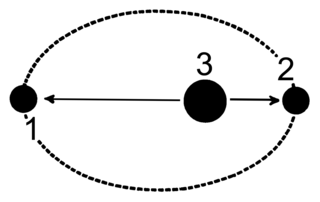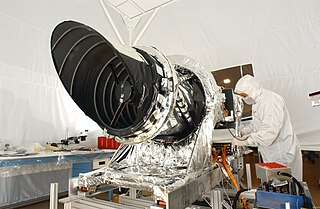
An eclipse is an astronomical event that occurs when an astronomical object or spacecraft is temporarily obscured, by passing into the shadow of another body or by having another body pass between it and the viewer. This alignment of three celestial objects is known as a syzygy. Apart from syzygy, the term eclipse is also used when a spacecraft reaches a position where it can observe two celestial bodies so aligned. An eclipse is the result of either an occultation or a transit.

In the context of spaceflight, a satellite is an object that has been intentionally placed into orbit. These objects are called artificial satellites to distinguish them from natural satellites such as Earth's Moon.

A low Earth orbit (LEO) is an Earth-centered orbit near the planet, often specified as having a period of 128 minutes or less and an eccentricity less than 0.25. Most of the artificial objects in outer space are in LEO, with an altitude never more than about one-third of the radius of Earth.

A natural satellite is, in the most common usage, an astronomical body that orbits a planet, dwarf planet, or small Solar System body. Natural satellites are often colloquially referred to as moons, a derivation from the Moon of Earth.

Spaceflight is an application of astronautics to fly spacecraft into or through outer space, either with or without humans on board. Most spaceflight is uncrewed and conducted mainly with spacecraft such as satellites in orbit around Earth, but also includes space probes for flights beyond Earth orbit. Such spaceflight operates either by telerobotic or autonomous control. The more complex human spaceflight has been pursued soon after the first orbital satellites and has reached the Moon and permanent human presence in space around Earth, particularly with the use of space stations. Human spaceflight programs include the Soyuz, Shenzhou, the past Apollo Moon landing and the Space Shuttle programs, with currently the International Space Station as the main destination of human spaceflight missions while China's Tiangong Space Station is under construction.

An apsis is the farthest or nearest point in the orbit of a planetary body about its primary body. The apsides of Earth's orbit of the Sun are two: the aphelion, where Earth is farthest from the sun, and the perihelion, where it is nearest. "Apsides" can also refer to the distance of the extreme range of an object orbiting a host body.

PSR B1620-26 b is an exoplanet of mythical status, located approximately 12,400 light-years from Earth in the constellation of Scorpius. It bears the unofficial nicknames "Methuselah" and "the Genesis planet" due to its extreme age and a few popular sources refer to this object as "PSR B1620-26 c". The planet is in a circumbinary orbit around the two stars of PSR B1620-26 and is the first circumbinary planet ever confirmed. It is also the first planet found in a globular cluster. The planet is one of the oldest known extrasolar planets, believed to be about 12.7 billion years old.
PSR B1829−10 is a pulsar that is approximately 30,000 light-years away in the constellation of Scutum. This pulsar has been the target of interest, because of a mistaken identification of a planet around it. Andrew G. Lyne of the University of Manchester and Bailes claimed in July 1991 to have found "a planet orbiting the neutron star PSR 1829-10" but in 1992 retracted. They had failed to correctly take into account the ellipticity of Earth's orbit, and had incorrectly concluded that a planet with an orbital period of half a year existed around the pulsar.

High Resolution Imaging Science Experiment is a camera on board the Mars Reconnaissance Orbiter which has been orbiting and studying Mars since 2006. The 65 kg (143 lb), US$40 million instrument was built under the direction of the University of Arizona's Lunar and Planetary Laboratory by Ball Aerospace & Technologies Corp. It consists of a 0.5 m (19.7 in) aperture reflecting telescope, the largest so far of any deep space mission, which allows it to take pictures of Mars with resolutions of 0.3 m/pixel, resolving objects below a meter across.

Gliese 876 b is an exoplanet orbiting the red dwarf Gliese 876. It completes one orbit in approximately 61 days. Discovered in June 1998, Gliese 876 b was the first planet to be discovered orbiting a red dwarf.
Upsilon Andromedae d (υ Andromedae d, abbreviated Upsilon And d, υ And d), formally named Majriti, is a super-Jupiter exoplanet orbiting within the habitable zone of the Sun-like star Upsilon Andromedae A, approximately 44 light-years (13.5 parsecs, or nearly 4.163×1014 km) away from Earth in the constellation of Andromeda. Its discovery made it the first multiplanetary system to be discovered around a main sequence star, and the first such system known in a multiple star system. The exoplanet was found by using the radial velocity method, where periodic Doppler shifts of spectral lines of the host star suggest an orbiting object.

The formation of the Solar System began about 4.6 billion years ago with the gravitational collapse of a small part of a giant molecular cloud. Most of the collapsing mass collected in the center, forming the Sun, while the rest flattened into a protoplanetary disk out of which the planets, moons, asteroids, and other small Solar System bodies formed.

The International Astronomical Union (IAU) defined in August 2006 that, in the Solar System, a planet is a celestial body that:
- is in orbit around the Sun,
- has sufficient mass to assume hydrostatic equilibrium, and
- has "cleared the neighbourhood" around its orbit.

A debris disk, or debris disc, is a circumstellar disk of dust and debris in orbit around a star. Sometimes these disks contain prominent rings, as seen in the image of Fomalhaut on the right. Debris disks are found around stars with mature planetary systems, including at least one debris disk in orbit around an evolved neutron star. Debris disks can also be produced and maintained as the remnants of collisions between planetesimals, otherwise known as asteroids and comets.
Gamma was a Soviet gamma ray telescope. It was launched on 11 July 1990 into an orbit around Earth with a height of 375 km and an inclination of 51.6 degrees. It lasted for around 2 years. On board the mission were three telescopes, all of which could be pointed at the same source. The project was a joint Soviet-French project.

The Saturnian moon Rhea may have a tenuous ring system consisting of three narrow, relatively dense bands within a particulate disk. This would be the first discovery of rings around a moon. The potential discovery was announced in the journal Science on March 6, 2008.
HD 101930 b is an extrasolar planet orbiting the star HD 101930. It has a minimum mass a third of Jupiter's, nearly the same as Saturn's so it is thought to be a gas giant. It orbits the star closer than Mercury, and the orbit is slightly eccentric.

Tiangong-3 was a proposed Chinese space station, part of the Tiangong program. The China National Space Agency (CNSA) was originally expected to launch Tiangong-3 around 2015, following the launch of the Tiangong-2 test laboratory, originally planned for 2013. The goals for the Tiangong-2 and Tiangong-3 laboratories were eventually merged, and the latter was therefore not ordered.

51 Pegasi b, officially named Dimidium, and formerly unofficially dubbed Bellerophon, is an extrasolar planet approximately 50 light-years away in the constellation of Pegasus. It was the first exoplanet to be discovered orbiting a main-sequence star, the Sun-like 51 Pegasi, and marked a breakthrough in astronomical research. It is the prototype for a class of planets called hot Jupiters.
















